The following article first appeared in the February 1956 (Vol. 25, No. 2 page 159) American Orchid Society BULLETIN as part of a multi-part Beginner's Handbook. It has been edited to reflect modern taxonomic synonymy. It does not include the former Brazilian unifoliate laelias such as Laelia purpurata that are now included in the genus Cattleya and would fit into the labiate group as they were considered distinct at the time the article appeared.
OF ALL THE VARIED KINDS OF ORCHIDS grown throughout the world, there is none which surpasses the Cattleya in popularity. Even though in some areas or among some individual growers other orchid genera have found high favor, it is still the Cattleya which means "orchid" to the lay person, it is the Cattleya which has been the mainspring of the orchid industry and it is the Cattleya which has done most to stimulate interest in orchid growing as a hobby. If we needed proof of this statement, we would only have to point to the florists' shops in the heart of the Cymbidium area where, advertising orchids, they use the Cattleya on their signs and shop windows. Or we could point to the "get-rich-quick-by-growing-orchids-at-home" advertisements which offer Epidendrum cuttings but portray Cattleyas in their ads. It is the lavender Cattleya which gained the now-hackneyed "an orchid to you" distinction, and although tawdry ostentation, cynical sophistication and the crude commercialism of whiskey hucksters have brought unsavory connotations to this flower, yet it still reveals to the novice, to the initiate, to the connoisseur a regal magnificence that defies the defilers. The Cattleya stands at the pinnacle of orchid eminence, the epitome of floral beauty.
Because of its importance, we shall take Cattleya as our first genus to discuss in detail. Actually, we shall deal with but one-half of the genus, now, for reasons which we will discuss presently.
THE GENUS CATTLEYA
History: - The first published account of any member of this genus to bloom in Europe appeared in Loddiges' BOTANICAL CABINET (t. 337) where it was illustrated and described as Epidendrum violaceum in 1819. Earlier, however, in 1818, Dr. W. T- Hooker had bloomed an allied species in his greenhouse in Suffolk, England, but he neither described it nor published any account of it at the time. The plant had been collected by Mr. William Swainson that year in the Organ Mountains about 60 miles north of Rio de Janeiro in Brazil, and a division of the same plant was obtained by Mr. 'William Cattley, a patron of horticulture and one of the first amateurs to form a collection of exotic orchids, his collection being the finest then known. When this new and beautiful orchid bloomed in November 1823 (the exact year is not certain as dates seldom accompanied the publications issued at this period), it was forwarded to the eminent orchidologist. Dr. John Lindley. who described it as Cattleya labiata in his COLLECTANEA BOTANICA, t. 33 (1824), establishing a new genus which he named in honor of Mr. Cattley. Recognizing at the same time the kinship of the earlier Epidendrum violaceum of Loddiges, he renamed this Cattleya loddigesii. Thus, the genus from its very inception was based on the two fundamental growth forms of Cattleya, the labiata form with one leaf and the bifoliate, or two-leaved, forms. The name "labiata" was applied because the lip was so prominent a part of the flower.
After the first importation from Mr. Swainson, no more plants similar to the original Cattleya labiata were discovered for many decades, although many varieties of this species were found. Each variety differed in some way from the plant of Mr. Cattley, either in color, blooming season or some similar horticultural aspect. Botanically, most of these one-leaved forms were considered as varieties and sub-varieties of Cattleya labiata. the original being termed C. labiata vera or the "true Cattleya labiata." As the number of variants grew to enormous proportions, and as hybridization began to utilize these forms, the cumbersome botanical nomenclature was modified and the varietal names were raised, in practice, to specific rank. Thus, we speak of Cattleya mossiae, Cattleya dowiana, Cattleya trianae, etc., rather than use the botanically correct name such as Cattleya labiata var. dowiana subvar. aurea, for instance.
Botanical description: - As is the practice in botanical science, Dr. Lindley described the genus clearly and concisely in Latin, but a broader resume in English is found in Veitch's MANUAL or ORCHIDACEOUS PLANTS. A paraphrase reduced to simplest possible terms is of value in understanding the genus and may be stated as follows:
Plant epiphytic on trees or rocks, thickened pseudobulbous stems with one or two (rarely three) leaves. Leaves thick, leathery or fleshy. Inflorescence unbranched, arising from apex of pseudobulb. usually emerging from spathe-like sheath. Flowers few, usually large and showy. Sepals free, nearly equal, spreading or rarely converging. Petals mostly broader than sepals. Lip attached to base of column, free above, usually three-lobed but rarely not; side lobes form tube enclosing column (except in C. bicolor); middle lobe spreading, sometimes distinct from side lobes, occasionally continuous with them. Column rather long, robust, half-rounded, without wings, slightly arching; anther at apex of column, incumbent, distinctly two-celled. Pollinia four, in two pairs, waxy, somewhat flattened, parallel.
The genus is divided into two sections: the first is distinguished by the club-shaped pseudobulbs which bear but a single leaf, while the second has long, spindle-shaped pseudobulbs bearing two leaves. The flowers of the unifoliate (one-leaved) group generally are larger, with broader flower segments; the flowers of the bifoliate group have narrower petals and sepals, smaller but thicker flowers. The floral characters, however, are not constant for the two sections. In this installment of the Beginners' Handbook, we will deal with the unifoliate or labiate group.
Allied genera: - The genus Cattleya is a prominent member of the larger grouping of genera known as the subtribe Laelieae. Many of the favorite orchids of horticulture are found in this subtribe, including Epidendrum. Diacrium, Broughtonia, Cattleya, Laelia, Schomburgkia (now included in the genus Laelia), Myrmecophila (segregated from Schomburgkia), Brassavola, Cattleyopsis, Sophronitis (now considered synonymous with Cattleya), Meiracyllium and Leptotes. The four pollinia of Cattleya distinguish it from Laelia, Schomburgkia, Brassavola and Sophronitis, each of which has eight pollinia. Like Cattleya, the genera Epidendrum, Diacrium, and Broughtonia have but four pollinia. Cattleya is separated from Epidendrum in that the latter genus has the lip adnate to (that is, growing attached to the length of) the column while in Cattleya the lip is free, a character that is not definitive in some of the small-flowered species., Cattleya is separated from Diacrium in that the latter genus has two thickened plates or calluses on the lip whereas Cattleya does not. Broughtonia has the lip produced into a spur, thus distinguishing it from Cattleya which does not.
Geographical distribution: - Cattleyas are found naturally only in the western hemisphere, occurring along with Laelias in three major regions of Tropical America: (1) Mexico and Guatemala; (2) northern part of South America from the western Cordilleras of Colombia to British Guiana; (3) the maritime provinces of southern Brazil.
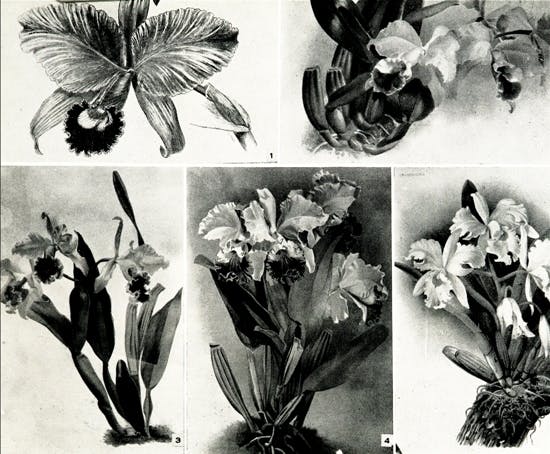
FIGURE 1. 1. Cattleya trianei from Veitch's Manual 2. C. gaskelliana from Reichenbachia 3. C. rex from Reichenbachia 4. C. mendelii 'Duke of Marlborough' from Reichenbachia 5. C. warscewiczii var. rochellensis from Reichenbachia
Within these three large regions are found most of the species of Cattleya except for C. dowiana in Costa Rica and C. skinneri var. autumnalis from Panama. Cattleya aurantiaca extends into El Salvador and Honduras as does C. skinneri. The plants occur at considerable elevation where the mean temperature is muchlower than the mean temperature for the latitude at sea level. This has great influence on their culture. In addition, the regional distribution influences the flowering season by virtue of the variation in the rainy season, which not only produces a "wet" growing stage and a relatively "dry" resting stage, but also is an indication of changing factors of temperature, day length and light intensity. Generally speaking, the rainy season in Mexico and Guatemala is from May to October, which is reversed in southern Brazil where the rainy season is November to April. The Colombia to Guiana region, being above the equator, has seasons like our own, the Cattleyas growing in summer, resting in autumn and winter. In southern Brazil, however, being on the opposite side of the equator, the seasons are reversed, and the plants bloom there according to their seasons.
THE UNIFOLIATE OR LABIATA GROUP
As we have indicated above, Cattleya labiata is a collective name for a group of Cattleyas which are remarkable for the size and beauty of the flowers. While there are many forms found in the wilds, and many distinctive forms are known to horticulture, the structural differences essential to scientific classification are either lacking or seemingly erratic and the entire group must be considered as one highly variable species. Yet horticultural features, such as blooming season, do exist and for that reason it is wiser for us to deal with the many subgroups as horticultural species.
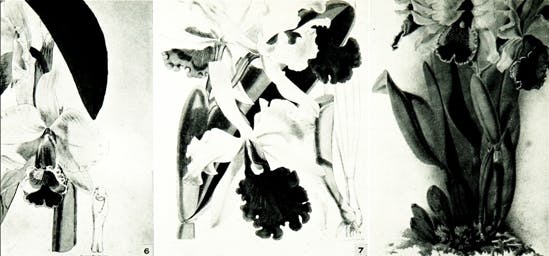
FIGURE 6 Cattleya candida (chocoensis, quadricolor) from Bateman's A SECOND CENTURY OF ORCHIDACEOUS PLANTS. 7 C. dowiana from Bateman's A SECOND CENTURY OF ORCHIDACEOUS PLANTS. 8 C. aurea (C. dowiana var. aurea) from Reichenbachia
The bulk of the labiate Cattleyas come from the Colombian-Guiana region, although Cattleya labiata and Cattleya warneri come from the mountains of Southern Brazil while Cattleya dowiana is found only in Costa Rica. Each of the different members of this group is restricted to a fairly distinct region, there being little overlapping of their habitats and hence few natural hybrids. However, the more intensive collecting of orchid growers in South America is resulting in the discovery of many variants and intergrades. A phytogeographic study of the labiate Cattleyas might be a very profitable undertaking someday, giving us a clearer understanding of the origin and classification of the group.
List of species: - The labiata group, as generally recognized at present, contains the following horticultural species. Wherever two or more names have been applied to the same form, the names which are no longer accepted, that is, the synonyms, are shown in parentheses. Cattleya candida (chocoensis, quadricolor). C. dowiana, C. aurea (C. dowiana var. aurea), C. eldorado, C. gaskelliana, C. Hardyana (natural hybrid), C. labiata, C. lawrenceana, C. lueddemanniana (C. speciossissima), C. mendellii, C. mossiae, C. percivaliana, C. rex, C. schroederae (C. schroederiana), C. trianae, C. warneri, C. warscewiczii (C. gigas).
In addition to the horticultural species of the Cattleya labiata group, there are several other quite distinct species included in this section because of the possession of thickened or clavate pseudobulbs bearing a single leaf. The additional species are C. luteola and C. maxima.
Blooming habits:
As an adaptation to their environment, the different species and horticultural species of the labiate Cattleyas have fairly definite blooming seasons. Recent developments show that in many instances the length of day determines the initiation of flowers (photoperiodism) and in some instances the temperature determines the blooming. Since both light and temperature will vary in the greenhouses of growers in different latitudes, the blooming season in the greenhouse may to a certain degree vary from that normal to the plant in its native habitat.
APPROXIMATE BLOOMING DATES OF THE MOST IMPORTANT CATTLEYAS
In addition to the time of year, there are differences in the manner of producing the flowers. As a general rule, Cattleya mossiae, C. mendellii, C. percivaliana and C. trianae flower from growths formed in the preceding season and after a period of rest. Cattleya dowiana, C. gaskelliana, C. eldorado, C. lueddemanniana, C. warscewiczii and C. warneri flower from growths formed during the current season and without a perceptible interval of rest. Cattleya labiata flowers from the growths formed during the current season but the buds do not emerge from the sheath until about two months after the pseudobulb and its leaf have completed growth.
Further, Cattleya labiata generally blooms from a double sheath, but this double sheath occasionally is found in other forms.
General culture: - Much of the information in earlier installments of this series applied especially to Cattleyas. Stated briefly, this labiate section requires ample light, humidity and ventilation. Day temperature will vary with the outside weather, but night temperature should not drop below 60F during the growing season and about 55F in the winter. Potting adult Cattleyas in osmunda is recommended for most hobbyists, or in tree fern, if you live in an area where that has supplanted the former. Seedlings may be potted in organic mixes for quicker growth. In most areas, feeding adult Cattleyas is not recommended for beginners, although seedlings may be fed and, in very sunny areas, the adults may be given a light application periodically. Watering should be thorough, enough to keep plants plump, with less water (but do not dry out) as the plants prepare to flower. After flowering, the plants can be kept drier until new growth begins. Review the earlier installments on culture, for the labiate Cattleyas are of intermediate cultural types, able to adapt themselves to varying conditions more readily than almost any other kind of orchid.
The following data on the species of Cattleyas in this section are necessarily brief and general. Each species constitutes a fascinating study in itself, and each is variable in the details of its coloring, habits and behavior. The whimsy of Nature is nowhere so clearly expressed as in this group of flowers, so beautiful as to make it a major concern of botanists, horticulturists, geneticists and an endless array of lesser-titled people; yet so variable, so complex and so unfathomable as to render science and the mind of man impotent in the face of Nature.

Cattleya candida (chocoensis, quadricolor): Colombia. Similar to C. trianae. Named C. quadricolor by Lindley, but no description published until 1864, when Bateman described it in GARDENERS' CHRONICLE. Sepals and petals large, broad, white or flushed with pale lilac, with fringed margins. Lip is yellow, stained in front with rich magenta, coloring somewhat variable. Flowers fragrant but do not open fully. Free-flowering, November to January.

Cattleya dowiana: Costa Rica. Originally discovered by Warscewicz about the year 1850. Sepals and petals nankeen-yellow; middle lobe of lip broad and spreading, with velvety texture, rich crimson-purple streaked with golden veins radiating from the center, three heavier golden veins passing longitudinally from the base to the apex. The original collections were lost, and it was not until 1865 that Mr. Arce, a native naturalist, rediscovered it, sending plants to Mr. G. Ure Skinner by way of a Captain Dow for whom it was named by Mr. Bateman in the GARDENERS' CHRONICLE in 1866. The flowers are from five to seven inches across, usually two but up to seven on a cluster. Becoming scarce in its restricted habit, it is seldom grown, the variety aurea being favored.
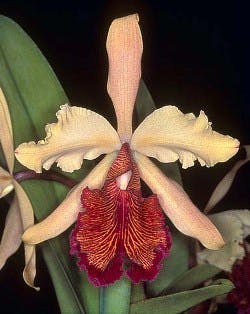
Cattleya aurea (dowiana var. aurea): Colombia. Discovered by Gustav Wallis in 1868, near the town of Frantino, it has been considered a distinct species because of the geographical separation of the two forms. Similar in plant characters to C dowiana, but the petals and sepals are deeper yellow, with richer golden veins more irregularly distributed on the lip. More free-flowering and striking in its coloration, the variety aurea has been used extensively in hybridizing.
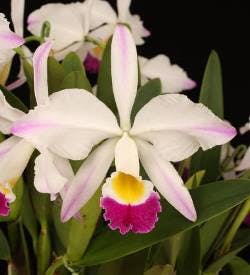
Cattleya wallisii (eldorado): Brazil. Discovered about 1866 and exhibited by M. Linden in Paris in 1867, it was first figured in Van Houtte's FLORE DES SERRES in 1869-70. Flowers smaller than those of C. labiata, lip tubular, front lobe less spreading. Sepals and petals pale lilac to white. Lip with a deep orange-yellow disc surrounded by white, tipped with purple edging or blotch. The pseudobulbs are usually more rounded and smoother than most Cattleyas in this group, the leaves more rigid and erect. Grows in warmer climate than most of the members of this section, with ber wet and dry seasons. It has a number of color phases described as varieties. It blooms from about July to September but is seldom found in present-day cultivation.
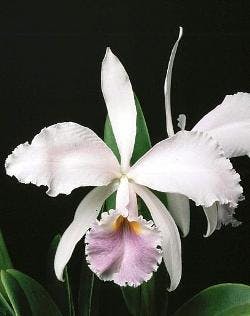
Cattleya gaskelliana: Venezuela. Introduced into England in the spring of 1883, by Sanders, it was named for Mr. Holbrook Gaskell of Woolton. It is intermediate in character between C. mossiae and C. lueddemanniana. Flowers large, six to seven inches, the color varying from medium amethyst purple to pure white. The lip is fairly large, the tube the same color as the petals and sepals, the lobe deep violet with pale border, the throat streaked with yellow and yellowish white. The flowers are usually soft but some fine varieties have been named. Blooms from mid-June to early September, growth beginning in early spring and flowering following without interruption. A nice variety for the hobbyist, still grown commonly, even occasionally as a commercial cut flower.

Cattleya Hardyana: Colombia. A natural hybrid between C. aurea and C. warscewiczii, it is an excellent plant for the amateur. Flowers large, up to eight inches, from three to five on a cluster. Sepals and petals are bright rose-purple, slightly paler at base. The broad frilled lip, about three inches across, is deep magenta-crimson with throat veined in gold, resembling the C. aurea parent, two rich orange-yellow "eyes" on the lip resembling the C. warscewiczii parent. It was named for Mr. G. Hardy of Pickering Lodge, Timperley, in whose collection it first flowered in 1889, having been received with a shipment of C. warscewiczii. Blooms in the summer, with very fragrant flowers.
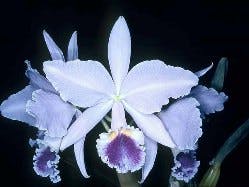
Cattleya labiata: Brazil. The true C. labiata is a free-flowering species, bearing from two to five flowers, each from five to six inches across. The petals and lip are well balanced, the latter being more open than in C. eldorado but not as flat as in C. dowiana. Although quite variable in color, the basic pattern consists of rose-colored wavy petals, sepals the same color, the ruffled lip rich crimson-purple bordered with lilac. The origin of this species is told in the introductory sections of this article. The species is among the most important horticulturally and for commercial flower production. While replaced in the cut-flower trade by its outstanding hybrid progeny, it is notable for the ease with which its blooming season can be controlled by the use of light. Starting its growth in late March or April, it grows rapidly in the bright warm summer months, flowering immediately in the fall from October through November. Since it initiates buds on a shortening day, it is possible to retard flowering by maintaining a long day with the use of artificial light. When the light is discontinued (according to a timetable best established by each grower) the normal process begins and the plants flower at a date much later than normal, being directed toward the Christmas holidays and later. An excellent plant for the hobbyist, as are many of its hybrids. Produces a double sheath, a character occasionally passed on to its hybrids.
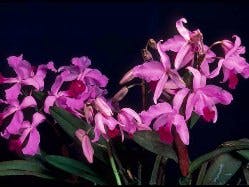
Cattleya lawrenceana: British Guiana. First discovered by Sir Robert Schomburgk during his explorations of 1840-44, it was mistaken for C. mossiae. Rediscovered in 1884 by Mr. Seidl while collecting for Sanders, it was described by Reichenbach in 1885 in GARDENERS' CHRONICLE, the name honoring Sir Trevor Lawrence, then President of the Royal Horticultural Society. A variable species, it is akin to the labiata group, although distinct in its more spindly pseudobulbs. The five to seven flowers are each about four to five inches across, with petals and sepals varying from pale rosy purple to nearly white. The lip is rolled over the column in a tube, externally colored like the sepals and petals. The front lobe is open, purple shaded with maroon, below which are two white striated blotches, separated by a purple band that reaches to the base of the tube. Blooms in March and April. Not commonly available.
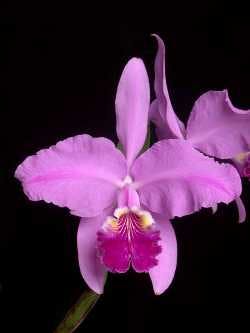
Cattleya lueddemanniana: Venezuela. Another species with a confused background, it has been grown under several names, including C. speciossissima and C. dawsonii. The type description, however, was by Reichenbach in XENIA ORCHIDACEA in 1854, in compliment to the gardener of M. Pescatore of Paris. From three to four flowers are produced, up to eight inches across, varying from purplish rose to pure white, the petals being nearly three times the width of the sepals. The lip is similar in color to the petals and sepals except the front lobe which is rich amethyst-purple, with two pale yellow or whitish blotches at the throat. The form is variable, and this horticultural species is not clearly defined. There is considerable variation in its native habitats, hence, equal variation in the behavior of individual plants which may flower from spring to late summer, according to origin. Some forms are free-flowering, especially those which bloom early. Those which bloom in August and September frequently are more difficult to flower, probably because of the lack of cool night temperature in the summer months.
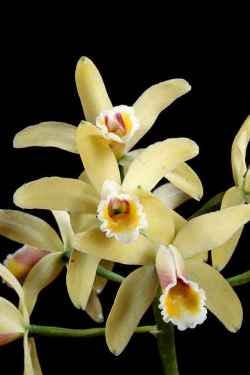
Cattleya luteola: Brazil and Peru. Described by Lindley in GARDENERS' CHRONICLE in 1853, it had been in cultivation for some years previously. A distinct species, from the upper regions of the Amazon, it is a delightful plant for the hobbyist. The habit is dwarf, five to seven inches in height, with ovoid pseudobulbs and leaves about three inches in length. The flower stems are shorter than the leaves, bearing from two to five flowers. Each flower is about two inches across, pale lemon yellow with the margin of the front lobe whitish and the side lobes streaked with purple on the inner side. The petals are not much wider than the sepals, the lip tubular with a ruffled but not wide-spread front lobe. Free-flowering throughout the year in its native Brazil where it is widely grown on trees, it is more reluctant in cultivation, blooming in early winter.

Cattleya maxima: Ecuador, Peru and Colombia. Originally collected in 1777 by the Spanish botanists, Ruiz and Pavon, who explored the Cinchona forests of Peru for their government, the specimens remained in their herbarium material until 1831 when it was partially described by Lindley in his GENERA AND SPECIES OF ORCHIDACEOUS PLANTS. It reappeared in collections by Hartweg in 1842, flowering in the gardens of the Horticultural Society of London in 1844, but died out. In 1855 it was flowered again by Mr. W. G. Farmer and has been in cultivation since, although never commonly nor as a commercial cut flower. Despite its name, it is not the largest of the Cattleyas, the flowers ranging from five to about seven inches across. The original form was deep lavender, the ruffled and spreading lip rose to lavender with a citron-yellow band running down the length of the tube, and a network of deep crimson veins covering the front lobe. The petals and sepals are narrower than in the labiata Cattleyas, and the form of the flower is quite open, bringing it into disfavor with the hybridists. However, it blooms freely, is vigorous in growth and the bright color of the flowers make them most attractive in the hobbyist's greenhouse. It frequently makes two growths a year and blooms from each, the season of bloom varying greatly but more commonly in winter. A plant with 13 blooms exhibited by George M. Wagner, Jr., received a Certificate of Botanical Merit from the American Orchid Society in February 1949.

Cattleya mendelii: Colombia. First figured in the FLORAL MAGAZINE in 1872, it was originally introduced in 1870 by Low and Company, and shortly after by Backhouse who named it in compliment to Mr. Sam Mendel, of Manley Hall, near Manchester. A distinctive form, it is characterized by the abrupt contrast afforded by the rich purple of the front lobe of the lip with the yellow disc. The petals and sepals are a delicate tint, white flushed with rosy mauve, the petals usually a shade darker than the sepals. The brilliantly colored lip is heavily ruffled and indented, making the flower extremely attractive although the delicate coloring of the flowers is scorned by the commercial florists who demand dark flowers for the trade. It is easy of culture, producing two to three flowers from six to seven inches across. Blooming season about April and May, from growths formed the previous fall. Recommended for the hobbyist.

Cattleya mossiae: Venezuela. First introduced by Mr. George Green who received it from La Guaira, Venezuela, in September 1836, it flowered in the collection of Mrs. Moss of Otterpool, and was named for her by Sir William J. Hooker who described it in the BOTANICAL MAGAZINE in 1839. One of the most popular and useful of the Cattleyas, it is extremely variable in form and coloring, particularly on the lip. A free-flowering, vigorous variety, it produces from three to four flowers on the spike, each flower from six to eight inches or more in size, the petals broad, somewhat fluted on the margins, the sepals and petals ranging from deep lilac to white. The broad lip is flattened but has a frilled margin, is very variable in color but basically is the same color as the petals and sepals, with yellow in the throat and disc, the front lobe marked with broken streaks or blotched with violet, the margin being lilac. This is commercially the most important Cattleya, blooming in April and May for the Easter and Mother's Day trade. Further, its blooming season can be somewhat modified through temperature controls, to fit the variable date of Easter. There are many new hybrids, however, providing competition in this field. The named varieties of C. mossiae are almost as numerous as those of C. trianae, its nearest rival in popularity and use. A wonderful plant for the beginner, particularly if a selected form is obtained.
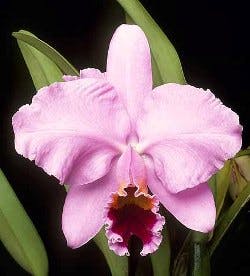
Cattleya percivaliana: Venezuela. Named for Mr. R. P. Percival, an English orchid grower, it was described by Reichenbach in GARDENERS' CHRONICLE for 1882, having been introduced in that year by Sanders of St. Albans, through their collector Arnold, who found it in the Cordillera of Venezuela at altitudes around 4,000 feet. Two to four flowers are produced on each stem, the flowers about four to five inches across. Petals are rosy lilac suffused with purple, the sepals frequently a little paler. The lip is smaller than in most labiata Cattleyas, quite variable in coloring and beautifully frilled. The front lobe of the lip is crimson-purple, shaded with maroon and spotted with yellow toward the throat. Usually, an easy bloomer and a vigorous grower, it was at one time highly valuable as a source of cut orchids for the Christmas season but is now pretty much replaced by hybrids. Called the Christmas orchid because of the season at which it flowers, December to early January, it is a delightful plant for the hobbyist.

Cattleya rex: Peru. Of obscure origin, this plant first appeared in literature when described in GARDENERS' CHRONICLE for 1890 by James O'Brien. It was "lost" for years, only to be rediscovered in 1940 by Harry Blossfeld. The species is still quite rare and seldom seen in cultivation. There are from three to six flowers on a stem, each flower about six inches across. The sepals and petals are creamy white to yellow, the crimson lip is veined with yellow, the margin white and ruffled. It blooms in late summer, resting during the winter, growth being resumed in early spring.
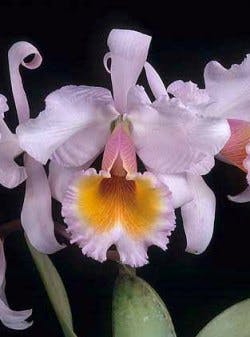
Cattleya schroederae: Colombia. Described as a variety of Cattleya trianae in GARDENERS' CHRONICLE in 1887, this form is quite distinctive and deserving of rank as a horticultural species. Named for Baroness Schroeder, the flowers are of a uniform delicate blush suffused with white, the disc of the lip pale orange-yellow. The petals and lip are quite ruffled, a character not found in C. trianae, and the entire flower has a delicacy that makes it most charming. It is approached by the varieties of C. trianae such as 'The President', 'The Baron', etc., as far as form and coloring (except the lip) but is closer to C. mossiae in its flowering and growth characteristics, growing from May to September after which it rests with sheath made up to flower the following March to May. Very fragrant, it is another delightful acquisition for the hobbyist, producing the delicate flowers for the Easter season.
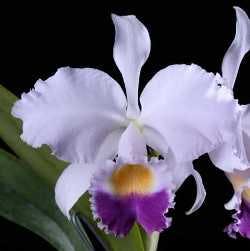
Cattleya trianae: Colombia. This, one of the most popular and variable of the labiata Cattleyas, has an involved history, first being introduced by Mr. Rucker of West Hill, Wandsworth, who received it from a correspondent in Colombia. After it flowered, it was submitted to Dr. Lindley who considered it a new species and called it Cattleya quadricolor, referring to the four colors observable in it. Lindley published no description, however, and the flower remained unrecorded until 1864 when Bateman described it in the GARDENERS' CHRONICLE, a figure appearing in the BOTANICAL MAGAZINE the following year. However, a few years previously, a Cattleya was received from Colombia by M. Linden, and described by Professor Reichenbach in BOTANISCHE ZEITUNG for 1860, who named it Cattleya trianae after Dr. Triana, a botanist from Bogota. Meanwhile, Lindley's C. quadricolor was considered referable to this concept, although not all botanists or horticulturists agree on this matter. The flowers are from five to seven inches across, from three to five flowers on a stem. The sepals and petals vary from pure white to, more usually, lilac to amethyst-purple. The lip is not as broad or spreading as in the other labiata Cattleyas, the tube colored as the sepals and petals, the front lobe purple-crimson with the throat orange marked with purple. This variety has many forms which have been recognized by name and by awards. It has been used extensively in breeding and is grown widely both horticulturally and as a commercial cut flower. It blooms in the winter, making it valuable for the Christmas holidays, from December to February.
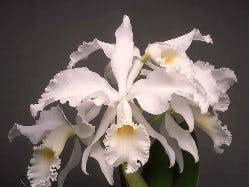
Cattleya warneri: Southern Brazil. Dedicated to Mr. Robert Warner, of Broomfield, in whose collecion it first flowered in 1860, it was figured and described in Warner's SELECT ORCHIDACEOUS PLANTS, t. 8, about 1862. The flowers are large and open, from six to eight inches across, from three to five to a stem. Sepals and petals are pale lilac to rosy mauve, the tube of the lip about the same shade or darker. The front lobe of the lip a rich crimson-purple, with the frilled margin rosy mauve. The throat is orange-yellow with lilac to white striations. Starting its growth in late winter, somewhat earlier than C. labiata, it forms its sheath and flowers without pause several months earlier than true C. labiata, the flowering season being about May and June, sometimes into July.
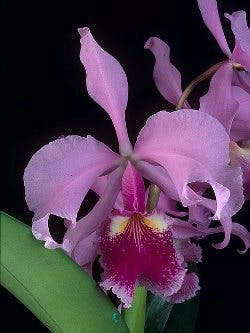
Cattleya warscewiczii: Colombia. Discovered in the province of Medellin, Colombia, around 1848 or 1849, by Warscewicz, the prominent orchid collector, the bulk of the shipment was lost through a breakdown of the vessel conveying the plants down the Magdalena River, but herbarium specimens were saved and sent to Reichenbach. Described by Reichenbach in XENIA ORCHIDACEA in 1855, it was named after its collector. A few plants were collected on occasion, but it was not truly rediscovered until Roezl, another famous collector, visited the original locality collected by Warscewicz. It became quite famous as one of the finest of the labiata Cattleyas. Flowers are from seven to nine inches across, two to three flowers to a stem. The sepals and petals are rose-mauve, the lip large, broad, spreading with a deep sinus or indentation at the apex of the front lobe. The side lobes of the lip are colored similar to the sepals and petals, the front lobe a rich crimson-purple, with two striking yellow "eyes" leading into the throat. This horticultural species is found naturally in habitats exposed to the sun and hence is frequently difficult to flower in cultivation where it needs maximum light. It requires high humidity but needs a period of severe drying off to induce blooming. A fine plant for any collection where light is ample during the late winter and early spring months. It blooms from late May to September, immediately after growth is completed.




